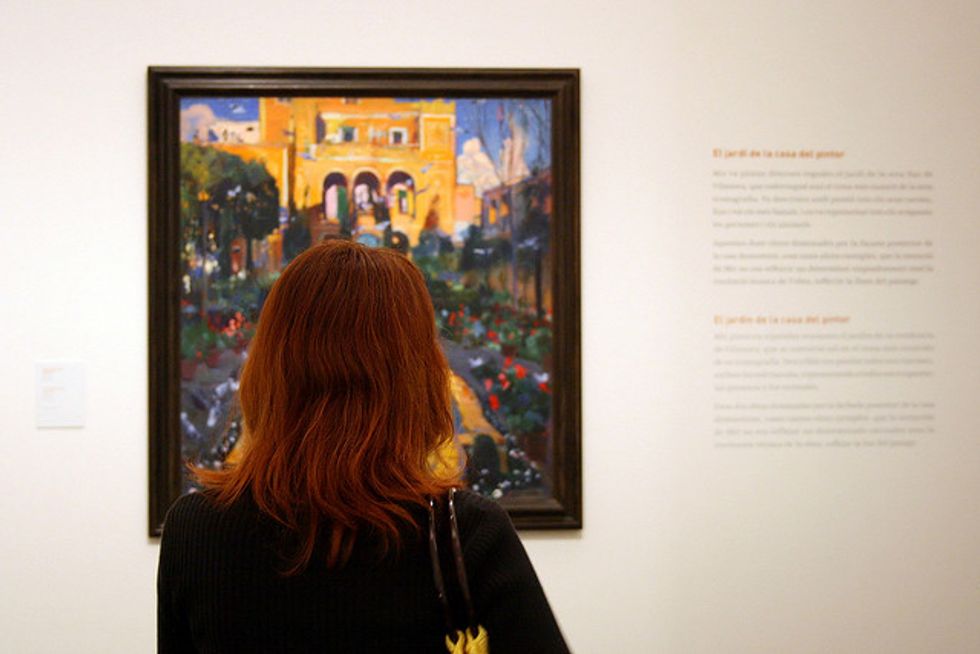I have a terrible confession to make. Get ready because this one might shock you. I don’t really like art. I’ve never quite understood why some works are considered masterpieces, and I think most modern art belongs in the trash. Sure, it’s not like I’ve just revealed myself to be a degenerate psychopath, but in San Francisco, my crime is right up there with drinking Cabernet ice-cold, preferring Safeway-brand ice cream to Bi-Rite, and voting Republican. You probably know someone else who does it, but admit it: You judge them harshly.
When it comes to art, I feel like I’m missing the point. I took an art class in college and nearly failed because I could never recognize an artist’s signature brushstrokes or identify a painting’s symbolism, and more often than not, I just didn’t see what made the work so special.
Overexposure to the art scene and all its attendant pretension only further soured my opinions, and for that I blame my husband. When we met in Detroit just after graduation, Dan was a struggling poet (read: bartender with an English degree) and all of his friends were writers or artists (read: he knew a lot of other bartenders). So I began to find myself at various art shows and gallery openings, lured by the promise of free wine and cheese and a fervent desire to share the same interests as my new love.
We’d make our way around the room—him congratulating friends on their successes and offering thoughtful commentary on their work, me mostly just smiling and nodding. When I did join the conversation, I’d inevitably say something that branded me as unappreciative of the visionary who painted a canvas solid black or fused naked Barbie dolls into a giant molten mass of plastic legs and blond hair.
Overhearing a guy in impossibly skinny jeans talk about how a piece really “said something,” I’d roll my eyes and announce to Dan, “Maybe Jackson Pollock was just having a seizure.” Maybe I’m the only one in this gallery who knows the squiggly lines and looping brushstrokes could’ve been made by an 8-year old and that a TV wrapped in chains on a pile of McDonald’s debris doesn’t actually symbolize America’s enslavement to corporate advertising.
I’d happily resolve to avoid the art scene altogether, but I still want to support my husband’s passion (in return, he lets me drag him to frequent wine-tasting trips and listens to lectures on terroir). That’s how I continue to end up at galleries, eavesdropping on couples discussing Rothko, who is known for his simple color-blocked paintings that command millions of dollars at auctions. I like to picture Rothko in his studio, working with a template and simply switching out the colors and sizes of the squares or rectangles for each new work of genius—all while laughing about how he was duping the world. I like him a bit better when I think he was in on the joke.
It’s not that I can’t appreciate the talent it took Matisse or Renoir or Picasso to create their masterpieces, relegated as I am to expressing scenes via crudely drawn stick figures, but I think Oscar Wilde was on to something when he wrote in The Picture of Dorian Gray that “all art is quite useless.” When Wilde penned this often-misunderstood quote, what he meant was not that art is pointless, but rather that it’s only there to be looked upon and should not be expected to do anything else.
Like Wilde, I enjoy art as decoration—paint arranged on a canvas or raw material given shape—but when the art supposedly makes a statement, especially if the statement is so absurdly garbled that only the artist can hear it, then my limited interest disappears. So this sculpture made entirely of adhesive tape is actually about the impermanence of love? Only in an art gallery would such ideas be accepted and applauded.
Since meeting my husband, I have tried to gain a better understanding of art. I’ve spent hours touring the world’s museums, from Spain to Argentina to South Africa (all places, mind you, where the wineries equal or outnumber the art museums) and here in San Francisco. Yet I still feel like an outsider who just doesn’t get it. Even the works I find beautiful make me feel annoyed by my lack of emotional response.
Though it’s been nearly a decade since we lived in Detroit, when we revisit the city’s Institute of Arts, Dan can navigate right to his favorite painting and recall every detail of what it means to him and how he felt when he first saw it. All I remember of the first time he showed it to me—on one of our first dates—was the panic of trying to come up with something clever to say about it. I must have hidden my apathy well because many more gallery dates followed, and it was several months before I let my shameful secret slip.
In a handwritten letter to a fan, Oscar Wilde later elaborated on his thoughts about art. “A work of art is useless as a flower is useless,” he wrote. “A flower blossoms for its own joy. We gain a moment of joy by looking at it.”
I may not care about negative space or perspective or symbolism, but I care about my husband’s happiness, which gives me my own moments of joy. So when we’re at a gallery party and Dan asks me what I think about a series of photographs of run-down houses or a canvas dribbled with seemingly random drops of paint, I just smile and say, “The wine selection here is fantastic.”
Katie Hammel is a freelance travel writer and the editor of Viator, Inc.’s award-winning travel blog.
Calling all SF writers: Submit your story for consideration to ledger@7x7.com.






















